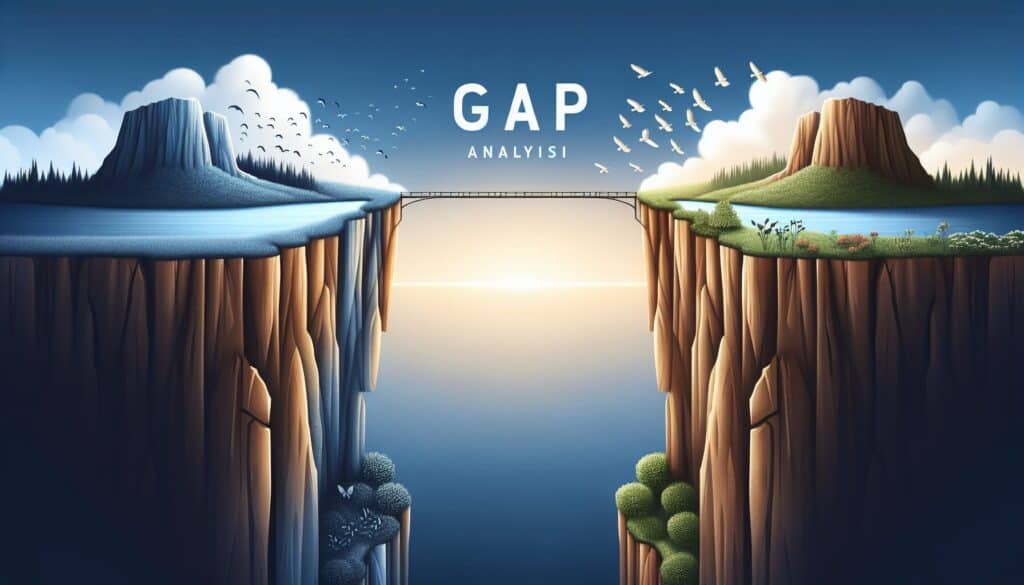A method to identify the difference (the “gap”) between a current state (how things are now) and a desired future state (how things should be or could be), and to determine the steps needed to close that gap.
- المنهجيات: الاقتصاد, لين سيجما, تصنيع, حل المشكلات, الجودة
Gap Analysis (Gap Filling)

Gap Analysis (Gap Filling)
- إدارة التغيير, التحسين المستمر, التصنيع اللين, تتبع الأداء, تحسين العمليات, إدارة المشاريع, ضمان الجودة, إدارة الجودة, إدارة المخاطر
الهدف:
كيفية استخدامه:
- Involves clearly defining the current state and the desired future state across various dimensions (e.g., performance, processes, skills, technology). The differences are then analyzed to identify specific gaps, and strategies or actions are developed to bridge these gaps.
الايجابيات
- Provides a clear framework for understanding current performance and identifying areas for improvement; Helps prioritize efforts and resources to achieve desired outcomes; Can be applied to various aspects of a business or project.
سلبيات
- Defining the "desired state" can be subjective or challenging; Can be overly simplistic if underlying causes of gaps are not explored deeply; Requires accurate assessment of the current state; Bridging the gaps often requires significant change management.
الفئات:
- العملاء والتسويق, الاقتصاد, لين سيجما, حل المشكلات, إدارة المشاريع, الجودة
الأفضل لـ
- Identifying discrepancies between current performance and desired targets, and developing action plans to achieve strategic objectives or improve processes.
Gap Analysis serves as a practical tool across various phases of product design, innovation, and engineering, particularly during the planning and assessment stages of project development. For instance, in the automotive industry, manufacturers may conduct a Gap Analysis to compare current vehicle performance metrics with future performance targets outlined in emerging regulatory standards or consumer expectations for sustainability. This methodical comparison allows design teams to identify specific areas needing improvement, such as fuel efficiency or safety features, and formulate strategic enhancement plans. Participants typically include cross-functional teams comprising project managers, product designers, engineers, and quality assurance specialists to ensure diverse input and comprehensive gap identification. In fields such as information technology, Gap Analysis can address disparities between existing software capabilities and advancements needed to meet evolving cybersecurity threats. The use of Gap Analysis extends to process optimization, where organizations in manufacturing may examine operational workflows to uncover inefficiencies against desired throughput rates. Tools like SWOT analysis or benchmarking against industry standards can complement Gap Analysis, enhancing its effectiveness in solidifying competitive advantage. This methodology offers a structured approach that not only aids in identifying deviations from strategic objectives but also promotes informed decision-making regarding resource allocation, aligning project efforts with organizational goals.
الخطوات الرئيسية لهذه المنهجية
- Define the current state across relevant dimensions.
- Identify the desired future state and specific targets.
- Analyze differences between current and desired states.
- Identify specific gaps in performance, processes, skills, and technology.
- Develop strategies or actions to bridge identified gaps.
- Prioritize gaps based on impact and feasibility of bridging efforts.
- Implement action plans to address prioritized gaps.
نصائح للمحترفين
- Utilize a structured scoring system to quantify and prioritize identified gaps, enabling data-driven decision-making for strategic resource allocation.
- Incorporate cross-functional teams in the gap analysis process to harness diverse expertise, ensuring comprehensive understanding of both current and desired states.
- Establish a feedback loop for continuous monitoring and adjustment of strategies as gaps are addressed, ensuring alignment with evolving organizational goals.
لقراءة عدة منهجيات ومقارنتها, نوصي باستخدام
> مستودع المنهجيات الشامل <
مع أكثر من 400 منهجية أخرى.
نرحب بتعليقاتكم على هذه المنهجية أو المعلومات الإضافية على قسم التعليقات أدناه ↓، وكذلك أي أفكار أو روابط متعلقة بالهندسة.
السياق التاريخي
1962
1970
1972
1980
1980
1986
1986
1960
1963
1970
1980
1980
1980
1986
1987
(إذا كان التاريخ غير معروف أو غير ذي صلة، على سبيل المثال "ميكانيكا الموائع"، يتم تقديم تقدير تقريبي لظهوره الملحوظ)















منشورات ذات صلة
حاسبة METS إلى السعرات الحرارية
التحليل التلوي
تخطيط الرسائل
مخططات النموذج الذهني
الحد الأقصى لقوى الدفع والسحب المقبولة
تخطيط الاحتياجات المادية (MRP)